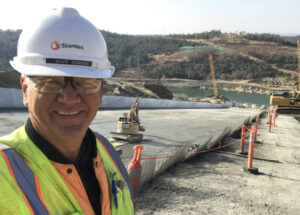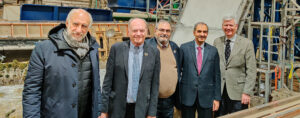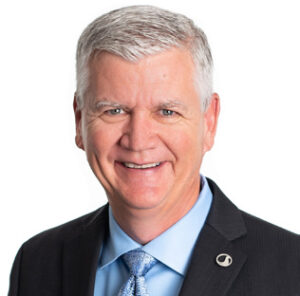Michael Rogers is an experienced civil engineer with 40 years of experience at Stantec Consulting Services, Inc., currently serving as the global practice leader for dams. Mr. Rogers has served in prominent roles in the United States Society on Dams (USSD) and the International Commission on Large Dams (ICOLD), of the latter of which he is currently president. During his time as ICOLD president, the organization has released a World Declaration on Dam Safety, which seeks to summarize and promote the dam safety knowledge collected by the 104 nationally based ICOLD member organizations all over the world. In this interview, Mr. Rogers tells Hydro Leader about the state of the global dam safety practice.
Hydro Leader: Please tell us about your background and how you came to be in your current position.
Michael Rogers: I am a civil engineer. I went to college at Illinois Institute of Technology, and as part of that education, I went through the co-op program and got a job at an engineering company in Chicago that specialized in dams and hydropower, Harza Engineering Company. Harza was subsequently acquired by Montgomery Watson, forming MWH, which was subsequently acquired by Stantec, where I currently work. I’ve essentially been with the same company for more than 40 years. I work exclusively in the field of dams and hydropower engineering. My specialties at Stantec are dam safety, dam rehabilitation, and the structural improvements of concrete dams using roller-compacted concrete, which is a modern material used in building concrete dams.
I’m currently the vice president of Stantec and a global practice leader for dam engineering. As part of my work in the industry, I started going to professional conferences with the USSD. I became active in the USSD’s concrete dam technical committee and sat on the board of directors. I have also served as the USSD’s vice president and president. USSD is one of the 104 national organizations that are part of ICOLD. I also served as chair of both the USSD’s and ICOLD’s technical committees on concrete dams. I helped organize ICOLD’s successful conference in the United States in 2013, and based on that experience, I was elected vice president of ICOLD and served a 3‑year term. After that, I ran for president and was elected in 2018. I am serving a 3‑year term as president that will finish at the time of our 2021 annual meeting.
Hydro Leader: Would you tell us about Stantec as a company?

Michael Rogers: Stantec is an international consulting engineering firm, active in a broad range of areas: transportation, building improvements, interior, and environmental. I work in the power and dams division, which includes thermal power, wind power, and hydroelectric power. My specific group is hydroelectric power and dams.
At Stantec, we firmly believe that communities are fundamental. Whether around the corner or across the globe, they provide a foundation, a sense of place and of belonging. That’s why at Stantec, we always design with community in mind. We care about the communities we serve—because they’re our communities too. We are designers, engineers, scientists, and project managers, innovating together at the intersection of community, creativity, and client relationships. Balancing these priorities results in projects that advance the quality of life in communities across the globe. Stantec trades on the Toronto and New York Stock Exchanges under the symbol STN. The Stantec community unites approximately 22,000 employees working in over 350 locations across 6 continents and is headquartered in Edmonton in Alberta, Canada.
Hydro Leader: Would you tell us about ICOLD’s history and its main activities today?
Michael Rogers: ICOLD was formed more than 90 years ago by a collection of countries that were starting to develop larger and larger dams. The technology that goes into building large dams is significantly more advanced than the technology for small dams, and it was recognized that more-developed countries, such as France, the UK, and the United States, were leading the way in research and design criteria for these large dams. It was necessary to share that knowledge with the world to ensure a common understanding of the state of the practice and to ensure the safety of the development of dams from the social and environmental standpoints.
ICOLD started in 1928 with member organizations from just five countries and has grown as more national organizations have joined. This year, three new countries joined—Kyrgyzstan, Laos, and Mongolia. As more countries have joined ICOLD, the organization has gained more knowledge of the state of the practice for engineering dams and levees. We’ve grown from focusing solely on large dams to focusing on dams and levees of all sizes and types.
We have 28 technical committees in which volunteer members meet and document the lessons they have learned and the state of the practice of dam engineering around the world. This allows countries where there’s a lot of work being done, like China, which is currently leading the world in developing larger dams and hydroelectricity, to share knowledge and technology with other areas of the world, especially developing countries that are just beginning to develop their water resources for renewable hydroelectricity, water supply, and flood control.
Hydro Leader: Is it accurate to say that ICOLD sets standards and guidelines, or is its work better described as information sharing?
Michael Rogers: Information sharing. We document the state of the practice, including general guidelines for development of dams and hydro projects in areas such as structural engineering and hydraulics for spillways. We don’t establish design criteria, but we set guidelines based on state of the practice and lessons learned from around the world, including from reputable organizations such as the Bureau of Reclamation and the U.S. Army Corps of Engineers, which are active in ICOLD.
Hydro Leader: What are some of the main methods of information sharing?
Michael Rogers: During our annual meeting, we have technical sessions and symposia on different aspects of dam design and share recent lessons learned. Every 3 years, we hold a congress that addresses specific questions related to a topic of interest. In 2021, we will hold our 3‑year congress in Marseille, France. It will address specific questions on climate change and other environmental aspects of dams; structural engineering for concrete dams; incidents and accidents concerning dams; and surveillance, instrumentation, monitoring, and data acquisition for dam safety.
The 28 technical committees themselves work more on long-term tasks, collecting knowledge and lessons through their professional communities and then publishing them in lesson plans and technical bulletins. We make our bulletins available to member countries free of charge. We also sell them to universities and other entities outside ICOLD countries. The documents are routinely used by dam professionals during the design and construction of dams as references on the state of the practice and guidelines for the safe development of dams.
Hydro Leader: Why did ICOLD decide to release the World Declaration on Dam Safety?
Michael Rogers: I started my tenure as president in 2018, after a number of high-profile dam incidents around the world, including the 2017 Oroville spillway incident in the United States. As president, I thought it would be worthwhile for ICOLD to develop a World Declaration on Dam Safety to reaffirm our commitment to the safe development of dams around the world. The declaration touches a few different areas, including ICOLD’s long-term mission and commitment to dam safety and the changing conditions of dam safety around the world, specifically in more-developed countries. The declaration also talks about the most important aspects of dam safety, including structural integrity, surveillance and monitoring, instrumentation, and basic design, and discusses what it means to have a successful dam safety program.
At Oroville, the periodic safety inspections and assessments of the dam were done better than they are at most projects around the world. However, the engineers had lost sight of the original design intent of the project, which is what ultimately contributed to the incident. Sharing the pillars of dam safety and laying out the changing conditions of dam safety are ICOLD’s way of reminding our members and ourselves that dam safety isn’t something to be taken for granted.
Hydro Leader: Now that it has released the statement, does ICOLD have specific activities that it will undertake to disseminate it and promote its message?
Michael Rogers: Yes. We have distributed the document to all 104 national member organizations and have asked that they share it with all their members. Overall, ICOLD’s national member organizations have a total of more than 15,000 members. One of the other ways we get the word out about the ICOLD World Declaration on Dam Safety is by going to other conferences to share it with organizations that are supported by or that support ICOLD. One of those organizations is Aqua-Media, which publishes The International Journal on Hydropower & Dams. It held a Hydro 2020 Conference, which was supposed to be in Strasbourg, France, but ended up being virtual. As an invited keynote speaker, I gave a speech on the ICOLD position on enhancing dam safety with specific reference to the World Declaration on Dam Safety. I’ve given similar speeches and keynote talks to conferences about the declaration in China and other countries around the world.
Hydro Leader: What are the challenges that different countries face when it comes to dam safety, and how do those differ in developed and developing countries?
Michael Rogers: There are different challenges that affect how dams are developed, designed, and refurbished in different countries around the world. Developed countries such as the United States have an aging dam inventory with an average age of almost 60 years. We have to be certain that our dams continue to meet their design intent. Moreover, in the case of dams that were developed for specific conditions that have now gone away or dams that can no longer be maintained in a safe and reliable manner, it may make sense to remove them.
For 40‑ to 50‑year-old dams in the United States, the challenges are balancing the continuing costs of maintaining the dam in a safe operating condition and protecting the people downstream, the environmental effects of the dam, and the benefits the dam provides. In some areas, the answers are changing. In some places, new features are being added to existing dams. For example, adding a hydropower project onto a lock and dam on the Mississippi or Ohio River makes it more beneficial.
Other countries have only recently begun to develop their water resources. For example, a lot of countries in Africa are trying to modernize their societies by providing access to clean, renewable power; water supplies; and flood control services. A dam owner in Africa is going to have completely different challenges than one in the United States when it comes to developing a dam and balancing its social and environmental aspects. Building a dam on a river usually has a large social effect, because people tend to live along rivers, and some of those areas may end up being flooded. The challenge is to balance those social and environmental costs with the benefit that is going to be provided by a dam for future generations.

Hydro Leader: Would you tell us about the effects of climate change on dam safety?
Michael Rogers: We know the climate is always changing. We try to adapt our dam design criteria to our knowledge of changing climate conditions as we develop our projects. For example, seismic design is based on historic earthquakes. The more earthquakes that occur, the more we understand about where faults are located, how big those faults are, and their potential for causing structural damage. Climate change is similar in that as time goes by, we learn more and more about changing climate patterns. Some areas are becoming wetter and getting more rain and higher flows, and some are becoming drier and warmer and getting less flow.
Dams can help moderate those changes. For example, in an area where changing rainfall patterns are delivering the same amount of water but over a longer period of time, dams can store water during periods with excess water and release it during dry periods. However, we have to be careful that our designs can adapt to the extreme events. High-hazard projects around the world have guidelines designed for maximum credible events, but when the climate is changing, sometimes those are moving targets. We have to adapt our design criteria to climate change. In some areas, that requires creating spillway or operational conditions that can pass floods higher than what is currently predicted or foreseen in a specific design period. For example, in certain areas, spillways must be designed for the 1‑in‑5,000‑year flood. But if we take climate change into consideration, we could design for an even more extreme event, like a 1‑in‑10,000‑year flood, or a greater one.
Hydro Leader: Would you provide some examples of how knowledge on dam safety issues is transferred through ICOLD?
Michael Rogers: ICOLD shares its information in a couple of different ways. One way is through our conferences. A lot of lessons were learned from the 2017 Oroville spillway failure, both about assessing dam safety and about recovering from a major, catastrophic event in a timely manner. ICOLD shared those lessons with the rest of the world in June 2018. Following the successful first year of the Oroville spillway project’s return to operation, ICOLD worked with the owner and other engineers to sponsor a special symposium and released a series of papers on different aspects of the incident that could be shared with the world. It was one of our most highly attended conferences. We talked about the underlying issues that led to the failure, the emergency action planning, the responses to the failure, and the technical design of the roller-compacted concrete spillway materials that were used to replace the rock that had been eroded and to provide a sound foundation for the spillway. Those lessons were shared with countries around the world.
Another way we share information is by supporting countries like India that are just now developing national dam safety programs. India has the third-largest inventory of dams in the world, but there was no national dam safety program—responsibility for dam safety lay at the state level. ICOLD worked with our member organization in India, the Indian National Committee on Large Dams, to support its Dam Rehabilitation and Improvement Program (DRIP), which aims to develop a common, nationwide program of dam safety. Working with the World Bank, the DRIP program has been able to document the situation, lay out the requirements of dam safety in India, and get funding for some basic safety improvements to existing projects.
When Malaysia joined ICOLD 2 years ago, it had no national dam safety program. Now, with the support of ICOLD and using ICOLD bulletins, the country has developed its own nationwide program for dam safety. Malaysia also called on ICOLD-affiliated experts to provide support, build capacity, and train its engineers. The Canadian Dam Association, for example, provided an array of experts to support the Malaysian National Committee at ICOLD in its development of national dam safety standards.
Hydro Leader: How will ICOLD be holding its 2021 events amid the COVID‑19 pandemic?
Michael Rogers: It is a moving target, obviously, as the whole world is pivoting toward the availability of vaccines. ICOLD is an international organization that is dependent on international travel for our meetings and annual conferences. Right now, we’re planning to hold our June 2021 International Congress in Marseille, France. We’re hopeful that with the vaccine, travel next summer will be viable. If necessary, it can be postponed to November 2021.
Our April 2020 in-person conference in New Delhi, India, was postponed to September 2020, postponed again to December 2020, and then postponed even further, to 2023. Instead, we held a virtual general assembly of all 104 countries on Zoom. In that meeting, we took care of the regular business, elections, and voting that were necessary to keep our organization moving forward and to meet our legal requirements. It was good, but we miss getting together. We enjoy having our technical discussions and our face-to-face discussions both in our formal conference session and informally during breaks, dinners, and so forth.
Michael Rogers is the president of the International Commission on Large Dams. He can be contacted at michael.rogers@stantec.com.
